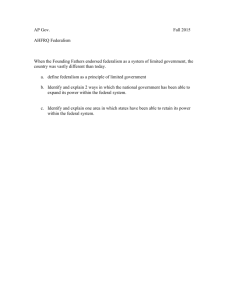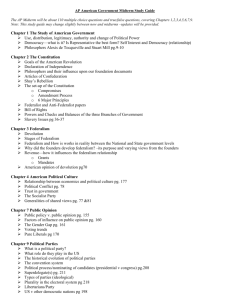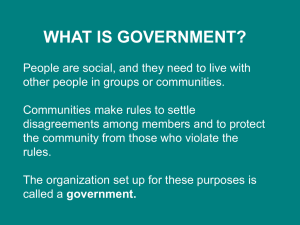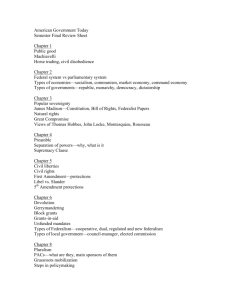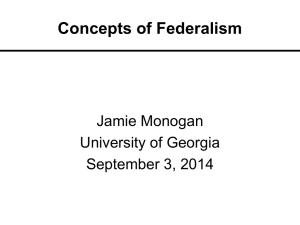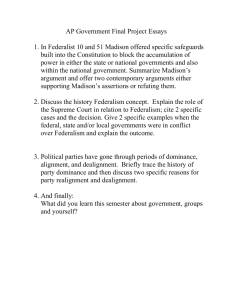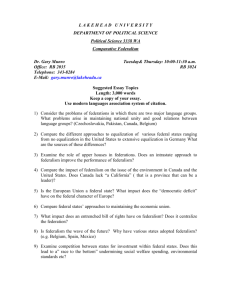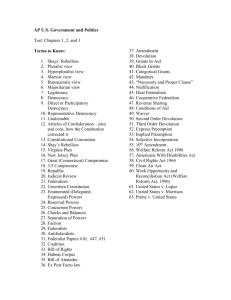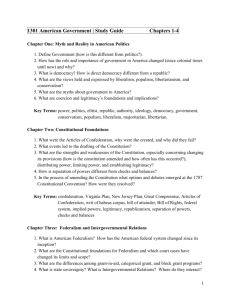Chapter Three - SCHOOLinSITES
advertisement
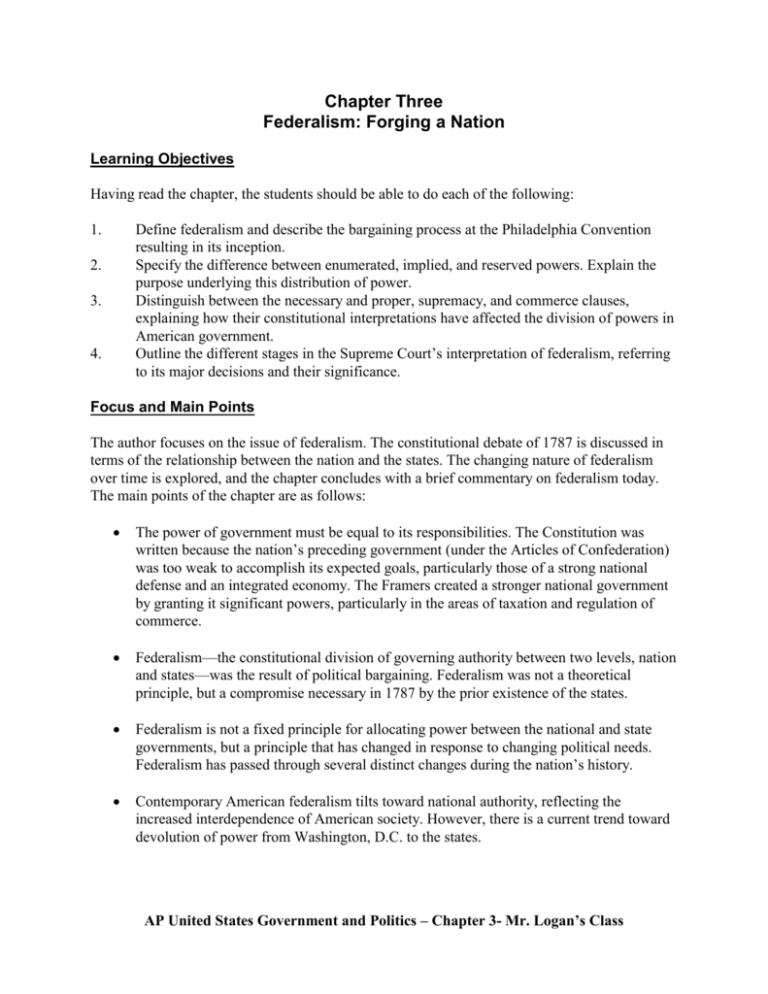
Chapter Three Federalism: Forging a Nation Learning Objectives Having read the chapter, the students should be able to do each of the following: 1. Define federalism and describe the bargaining process at the Philadelphia Convention resulting in its inception. Specify the difference between enumerated, implied, and reserved powers. Explain the purpose underlying this distribution of power. Distinguish between the necessary and proper, supremacy, and commerce clauses, explaining how their constitutional interpretations have affected the division of powers in American government. Outline the different stages in the Supreme Court’s interpretation of federalism, referring to its major decisions and their significance. 2. 3. 4. Focus and Main Points The author focuses on the issue of federalism. The constitutional debate of 1787 is discussed in terms of the relationship between the nation and the states. The changing nature of federalism over time is explored, and the chapter concludes with a brief commentary on federalism today. The main points of the chapter are as follows: The power of government must be equal to its responsibilities. The Constitution was written because the nation’s preceding government (under the Articles of Confederation) was too weak to accomplish its expected goals, particularly those of a strong national defense and an integrated economy. The Framers created a stronger national government by granting it significant powers, particularly in the areas of taxation and regulation of commerce. Federalism—the constitutional division of governing authority between two levels, nation and states—was the result of political bargaining. Federalism was not a theoretical principle, but a compromise necessary in 1787 by the prior existence of the states. Federalism is not a fixed principle for allocating power between the national and state governments, but a principle that has changed in response to changing political needs. Federalism has passed through several distinct changes during the nation’s history. Contemporary American federalism tilts toward national authority, reflecting the increased interdependence of American society. However, there is a current trend toward devolution of power from Washington, D.C. to the states. AP United States Government and Politics – Chapter 3- Mr. Logan’s Class Chapter 3: Federalism: Forging a Nation Chapter Summary The foremost characteristic of the American political system is its division of authority between a national government and the states. The first U.S. government, established by the Articles of Confederation, was essentially a loose alliance of states. In establishing the basis for a more powerful national government, the Framers also made provisions for safeguarding state interests. The result was the creation of a federal system in which sovereignty was vested in both national and state governments. The Framers carefully enumerated the general powers of the national government and granted it implied powers through the necessary and proper clause in Article I. Other powers are reserved to the states by the Tenth Amendment. From 1789 to 1865, the nation’s survival was at issue. The states found it convenient to argue that their sovereignty took precedence over national authority. In the end, it took the Civil War to cement the idea that the United States was a union of people, not of states. From 1865 to 1937, federalism reflected the doctrine that certain policy areas were the exclusive responsibility of the national government, while others belonged exclusively to the states. This constitutional position enabled the South to discriminate against African-Americans and promoted the laissez-faire doctrine that big business was largely beyond governmental control. Federalism, as we perceive it today, began to emerge in the late 1930s during the presidency of Franklin D. Roosevelt. In the areas of commerce, taxation, spending, civil rights, and civil liberties, among others, the federal government now has a very large role, one that is the inevitable consequence of the increasing complexity of American society and the interdependence of its people. National, state, and local officials now work closely together to solve policy problems, a situation that is commonly described as cooperative federalism. Grants-in-aid from Washington, D.C. to the states and localities have been the chief instrument of national influence. States and localities have received billions in federal assistance; in accepting that money, they have also accepted both federal restrictions on its use and the national policy priorities that underlie the granting of the money. In recent years, the relationship between the nation and the states has again become a priority issue. Power is shifting downward to the states, and a new balance in the ever-evolving system of U.S. federalism is taking place. This change, as has been true throughout U.S. history, has sprung from the demands of the American people. Major Concepts 1. 2. 3. 4. 5. 6. federalism (p. 73) sovereignty (p. 73) confederacy (p. 74) unitary system (p. 74) enumerated (expressed) powers (p. 77) supremacy clause (p. 78) AP United States Government and Politics – Chapter 3- Mr. Logan’s Class Chapter 3: Federalism: Forging a Nation “necessary and proper” clause (elastic clause) (p. 78) implied powers (p. 78) reserved powers (p. 79) dual federalism (p. 82) commerce clause (p. 85) cooperative federalism (p. 90) fiscal federalism (p. 92) grants-in-aid (p. 92) categorical grants (p. 92) block grants (p. 92) devolution (p. 93) 7. 8. 9. 10. 11. 12. 13. 14. 15. 16. 17. Lecture Outline This lecture outline closely follows the text in its organization. The instructor can use this outline as a lecture aid. The focus of this chapter is on federalism. The author describes the constitutional debate in Philadelphia in 1787 over the relationship between the national government and the states, explores how federalism has changed over time, and concludes with a brief commentary on federalism in contemporary America. Oregon’s Death with Dignity Act is typical of thousands of controversies concerned with whether state or national authority should prevail. This is due to the fact that Americans possess dual citizenship: they are both citizens of the United States and the state in which they reside. I. Federalism: National and State Sovereignty The decision to have a federal government is demonstrative of the Framers’ belief that a confederal form of government was destined to fail. Federalism is the division of ultimate governing authority (sovereignty) between national and regional governments. The arguments for federalism are as follows: it protects liberty, it promotes a responsive government, and creates a strong government thus overcoming the deficiencies of the Articles of Confederation. America’s national government has enumerated powers, which are designed primarily to enable it to provide for the nation’s defense and commerce. The national government also has implied powers through the necessary and proper clause which gives it the flexibility and responsiveness to meet changing national needs. The states’ powers are called reserved powers and are provided through the Tenth Amendment. AP United States Government and Politics – Chapter 3- Mr. Logan’s Class Chapter 3: Federalism: Forging a Nation The ratification debate revolved around the issue of national versus state sovereignty. Anti-Federalists favored a weaker national government and greater state authority. Federalists favored a stronger national government and greater national authority. II. Federalism in Historical Perspective Federalism has passed through distinct stages in the course of its development. The first phase from 1789 to 1865 was characterized by conflict between the nationalist and states’ rights views. The nationalist view held that when national and state law conflicted, national law was paramount. This was reflected in the McCulloch v. Maryland (1819) decision of the Supreme Court. The states’ rights view held that each state had the constitutional right to nullify a national law and is reflected in the Supreme Court’s Dred Scott (1857) decision. The nationalist view was upheld through the Union victory in the Civil War. Between 1865 and 1937, dual federalism and laissez-faire capitalism were the leading principles in federalism. Dual federalism held that a precise separation of national and state authority was both possible and desirable, and its influence is evident in the infamous Plessy v. Ferguson (1896) decision. Laissez-faire capitalism holds that business interests should be allowed to act as they please, with little or no regulation by the national government. Using this philosophy as its guide, the Supreme Court protected business from substantial regulation by either state governments or the national government. Both dual federalism and laissez-faire capitalism lost force as a result of social and economic change in the twentieth century. Despite many of its programs being initially opposed by a conservative Supreme Court, Franklin Roosevelt’s New Deal was eventually accepted by the Court. The justices broadened their interpretation of the federal government’s taxing and spending powers. III. Federalism Today Developments of recent decades have diminished state authority in the federal system. The actions of the national government are not likely to be blocked on constitutional grounds. AP United States Government and Politics – Chapter 3- Mr. Logan’s Class Chapter 3: Federalism: Forging a Nation The powers of the states are still vital, but far less autonomous than prior to the New Deal. The states and their citizens have become increasingly interdependent, providing the impetus for a stronger national government. This cooperative federalism involves national, state and local governments working together to solve policy problems. The national government’s fiscal advantage in raising money has often made money the basis of the relationship between the national and state governments. This fiscal federalism is the expenditure of federal funds on programs run in part through state and local governments. The national government provides some or all of the funds for given programs and the states and localities administer them. The devolution philosophy has emerged in recent years. Devolution is the idea that American federalism will be improved by a shift in authority from the national government to the state and local governments. This belief has been given impetus by fiscal constraints and the Republican congressional victories in 1994. IV. The Public’s Influence: Setting the Boundaries of Federal-State Power President Franklin Roosevelt’s programs, such as Social Security, attracted a great deal of public support. Lyndon Johnson’s Great Society programs of the 1960s reflected the desire of Americans for greater government involvement in public policy matters. Today, public opinion is in support of the current rollback in federal authority. The GOP victory in 1994 gave the Republicans numeric control of both chambers of Congress. The public confidence in Washington, D.C. has dramatically diminished. People feel that officials in Washington, D.C. do not care about them. Each generation of Americans has devised a balance of national and state power that serves its interests. Public opinion defines the boundaries of federal and state power. Complementary Lecture Topics Below are suggestions for lectures or lecture topics that will complement the text. In general, these topics assume that students will have read the chapter beforehand. The American federal system was the first of its kind. Other governments were unitary in nature. Identify the advantages and disadvantages of each type of system, keeping the size and diversity of the United States in mind. AP United States Government and Politics – Chapter 3- Mr. Logan’s Class Chapter 3: Federalism: Forging a Nation Provide a historical comparison of the responsibilities of the national and state governments. Identify similarities and differences. Should the national government be given more power at the expense of the states due to the increased complexity and interdependence which characterizes contemporary America? Shays’ Rebellion and economic chaos provided the impetus for the 1787 Philadelphia Convention. Are there any modern problems that have potentially significant constitutional implications? Consider possibilities such as abortion rights, the budget deficit and taxes, drugs, terrorism, and environmental degradation, among others. What constitutional changes might eventually result from debating these issues? AP United States Government and Politics – Chapter 3- Mr. Logan’s Class
